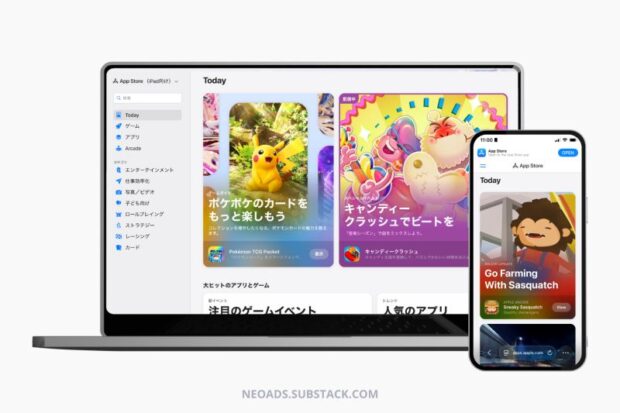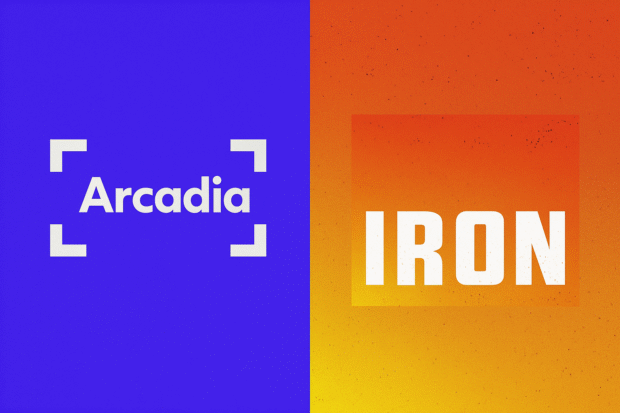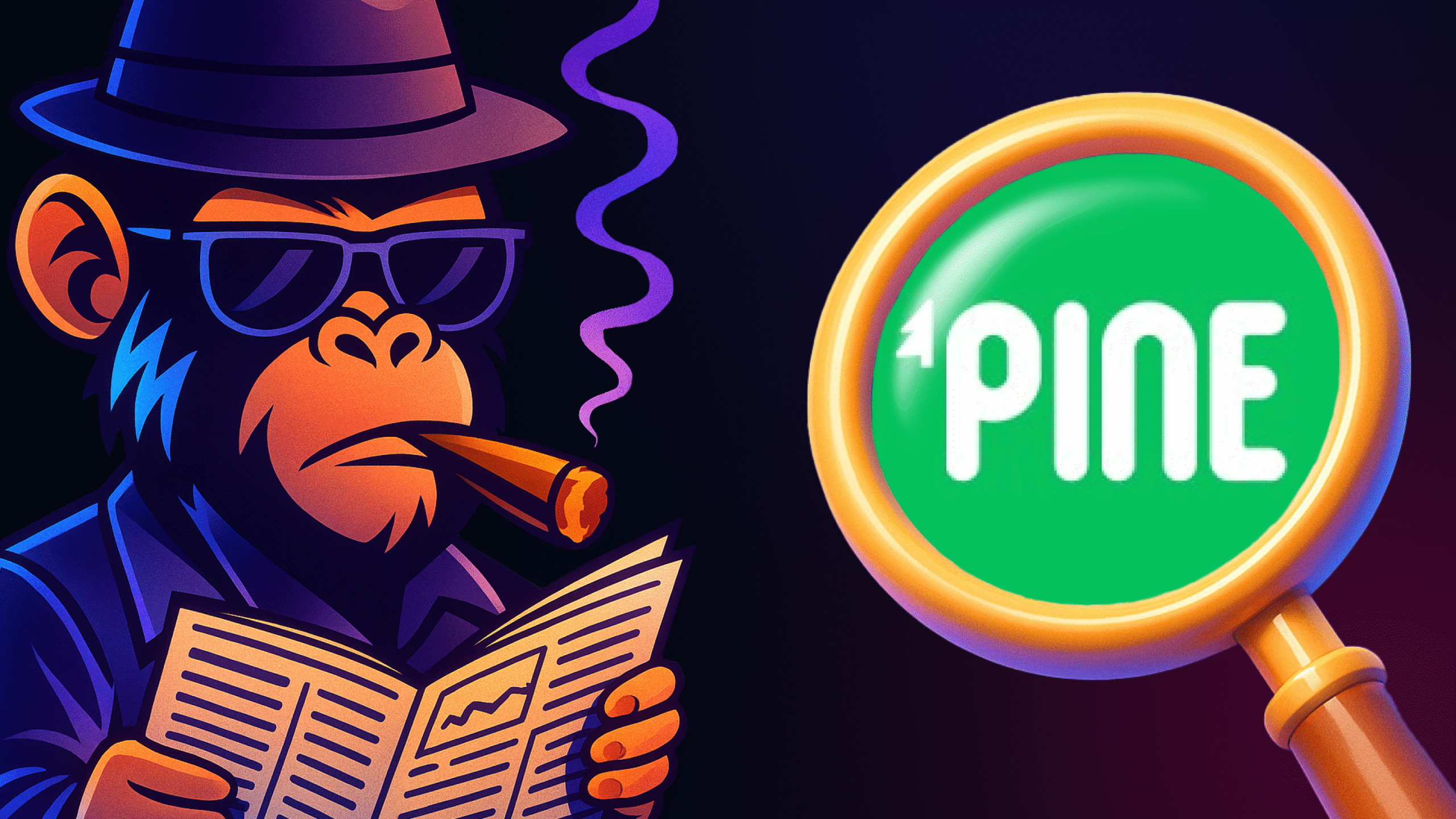
So many killer Studios & Games out there…
Every week, there’s something new to track, especially from Türkiye, Vietnam & China.
And, we’re constantly detecting them with my partner-in-CRIME, Yağız 🤟🏻

Today?
We’re diving into Viking Island!
A bold new Merge-2 hit from Pine Games, one of Türkiye’s fastest-rising studios 🇹🇷
We’ve all seen hundreds of Merge-2s & Puzzles come & go.
Right now, China’s running the show. Microfun alone has turned fast-following into an empire, outspending even Dream Games while still playing by the same formula…
Then Viking Island dropped, not another “Mom’s Revenge” or “Cheating Drama” merge. 😅
It’s got weight, texture, and attitude, masculine energy, art-heavy world-building, and a sense of creative ambition the genre desperately needed.
It still feels familiar enough to sit next to Merge Mansion or Gossip Harbor, but with its own tone, audience, and aesthetic that finally break the mold.
Today, we talk about Viking Island because Pine Games has made a bold move into the Merge-2 scene.
Let’s take a quick look back at how Pine got here.
It’s a young studio, steady, focused, and finding its own direction.
Here’s what you’ll find inside:
- 🎮 How Pine went from Word Weaver to Viking Island in under a year
- 🧩 Why Merge-2 still matters & how Pine is rewriting the ‘Playbook’
- ⚙️ The design touches that make Viking Island feel Fresh & Unique
- 🌱 What Pine’s evolution tells us about the new “Ever-green studio mindset”
🎁 Bonus: We Went All In.
While digging into Viking Island, we ended up capturing 700+ SS!
They were too good to keep to ourselves, so we’ll be sharing a selection soon.
👉 Download all the visuals here — Free & Open
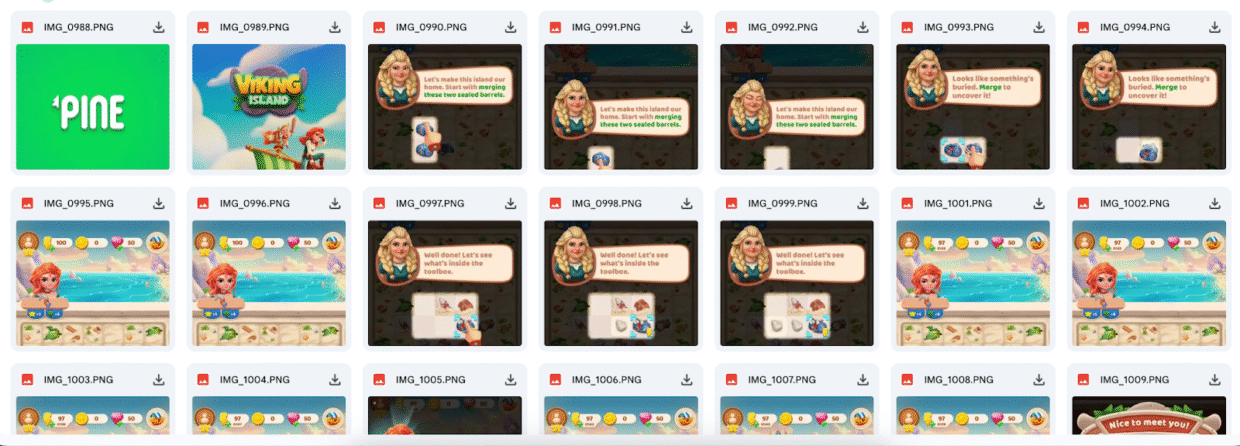
Pine Games – Let’s Remember
Pine Games was founded in 2024 by Yankı Yağız Akpek (ex-Peak & Bigger) in Türkiye.
The studio first made headlines that same January, raising $2.25M in a pre-seed round led by E2VC, Laton Ventures & Mert Gür, at a $10M valuation, a strong start for a brand-new studio making its mark early.

They brought together a wealth of experience from some of Türkiye’s most prolific puzzle traditions, uniting that expertise under one roof.
From D1, they made it clear that Puzzle Games would be their main focus.
At the time, no one realized it, but Pine was already moving forward with a dual-track vision.
On one side, the studio aimed to stay agile and trend-aware, producing short-term hits to remain active and relevant in the market.
On the other, it was committed to building long-term, IP-driven casual titles with staying power.
A similar approach has been successfully sustained for years by Easybrain, a fitting example of how this kind of balanced strategy can drive both stability and growth.
And just before announcing their investment, in the first week of Jan’24, they launched their very first game: Figures Match.

This project was significant as it marked the team’s first game built together.
Then, on March 19, Pine released a new title in the Word Puzzle subgenre: Word Weaver.
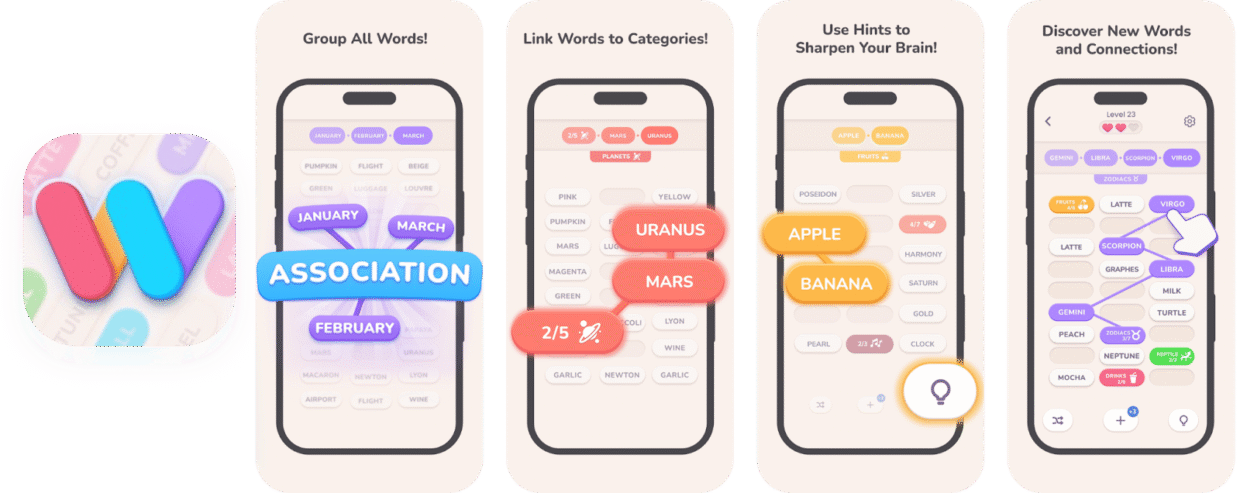
Word Weaver featured a core loop best described as a logic puzzle; players formed groups between words to clear the entire board.
And this time, Pine hit the mark. Word Weaver became the studio’s first title to reach the “Growth” stage, marking a real milestone for the team.

By September 2024, according to AppMagic data, the game had surpassed 200,000 downloads and generated over $20,000 in IAP revenue, not counting ad revenue.
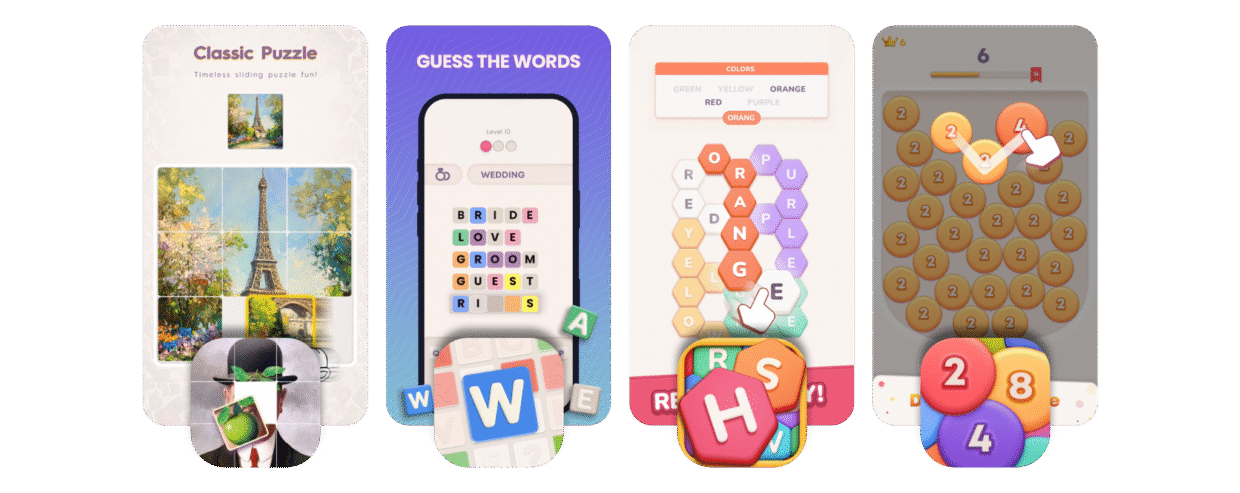
After that, they experimented with four more titles across the word puzzle, jigsaw, and connect puzzle genres.
However, among them, only Word Weaver managed to achieve scalable success.

By October 2024, as Word Weaver continued its steady climb, Pine returned to the stage with a fresh idea, Number Paint.
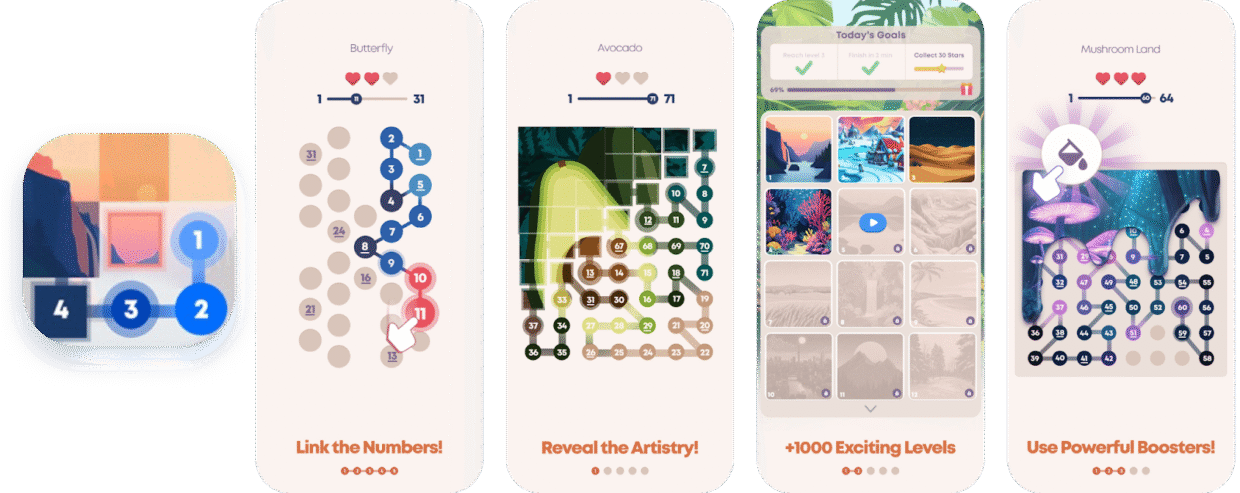
Number Paint combined link-based dot connect mechanics with a painting twist, creating a uniquely satisfying puzzle experience.
While it shared some of the same technical foundation as Hexa Search and Number Link, its visual painting theme added a warmer, more tactile feel to the gameplay. With that, Pine wrapped up its final release of 2024.

By the end of the year, Pine had reached roughly 500,000 downloads across its two successful titles.
Scale & Discovery
In its first year, Pine found success through two different subgenres, Number Paint & Word Weaver.
By 2025, both titles were still growing strong, showing no signs of slowing down.

By May 2025, Pine had surpassed 2 million downloads across its two flagship titles, generating around $150,000 in IAP revenue.
Considering its ad-driven monetization model, with roughly a 90/10 split between IAA & IAP, the studio’s real revenue likely exceeded $1.5 million.
Looking at the period from January 2024 to May 2025, Pine’s trajectory had become crystal clear.
The studio was steadily building around a Casual / Hybrid Casual model, blending Ad + IAP revenue and constantly experimenting with new genres and mechanics.
This approach kept Pine both current and ambitious, chasing not just trends but the next long-term hit.
But there’s another defining trait that stands out in Pine’s vision: adaptability.
The team moves with remarkable agility, quickly aligning with market shifts and new opportunities, turning Pine into a young yet mature studio that learns, evolves, and grows with every move.
A New Chapter in the Ever-Green Studio Vision
In a casual gaming market overflowing with Hypercasual, Hybridcasual, and countless Match-3 or Kingshot-style clones, the studios that carve their own path, the true ever-green ones, are becoming more valuable than ever.
These are the teams that set trends instead of chasing them, crafting long-lasting, character-driven, and original games.
Pine Games is fast emerging as one of the new representatives of that mindset, and its latest release, Viking Island, is the clearest reflection of this ever-green vision.
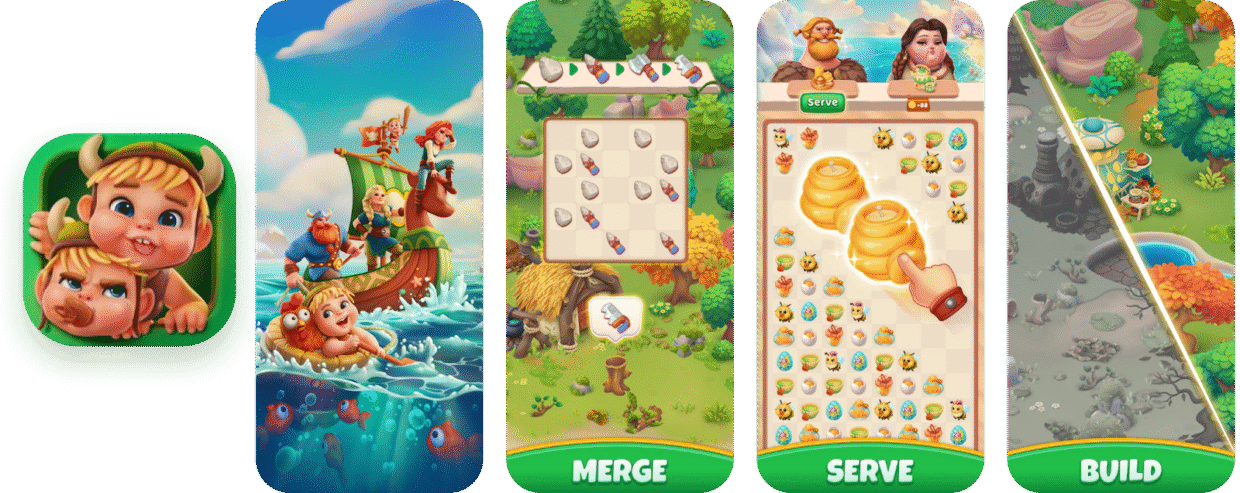
Viking Island is built on a Merge-2 & Complex Meta foundation, a combination that blends familiar mechanics with deeper progression systems.
But before diving into the details, let’s take a quick look at the Merge-2 genre itself.
At its core, Merge-2 games revolve around the idea of combining two identical objects to create a higher-tier version of that object, a simple yet endlessly expandable mechanic that’s powered some of mobile gaming’s biggest hits.

This mechanic is easy to learn yet visually satisfying, giving players a strong sense of progression. The feeling of clearing the board is what makes the genre so relaxing and rewarding.
The merge system works through chain-based progression. Each collectible item belongs to a progression chain, a level 1 object merges with another of its kind to become level 2, two level 2s form a level 3, and so on.
Players stay motivated through this chain reaction of growth, feeling closer to their goal with every higher-tier merge.
The core gameplay loop typically follows this pattern:
Produce resources → Merge → Complete tasks → Earn rewards.
Players are given generators that supply base-level items. Each action or production consumes energy; players drag and combine these materials to keep progressing.
In many ways, Merge-2 is the natural evolution of Merge-3.
The key difference lies in simplicity: while Merge-3 requires combining three objects to advance, Merge-2 streamlines the process to just two, making it faster and more accessible.
The Merge-3 genre first gained traction around 2017–2018 with early hits like Merge Dragons! by Turkish studio Gram Games (later acquired by Zynga) & EverMerge by U.S. developer Big Fish Games.
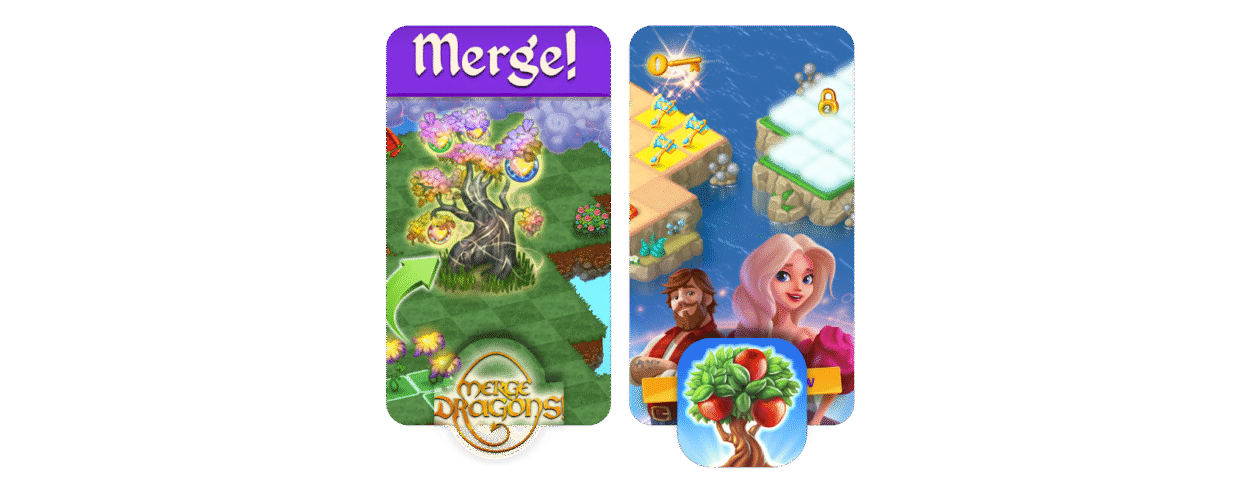
Over time, as the mobile gaming market evolved, Merge-3 gradually gave way to Merge-2 titles.
The first major commercial success in the Merge-2 space came in February 2019 with Dream Detective, developed by Century Games in Asia.
The game generated over $10 million in IAP revenue, marking a milestone for the genre, though it ultimately struggled to maintain long-term, sustainable growth.

A year later, Western developers entered the scene. Starberry’s Merge Mayor and Metacore’s Merge Mansion propelled the Merge-2 genre to new heights.
In particular, Merge Mansion became the first true hit of the genre — holding the title of top-grossing Merge-2 game for a long stretch.
Then came Moon Active from Israel with Travel Town, which went on to surpass Merge Mansion in both downloads and IAP revenue, creating a new balance within the genre and expanding its audience even further.
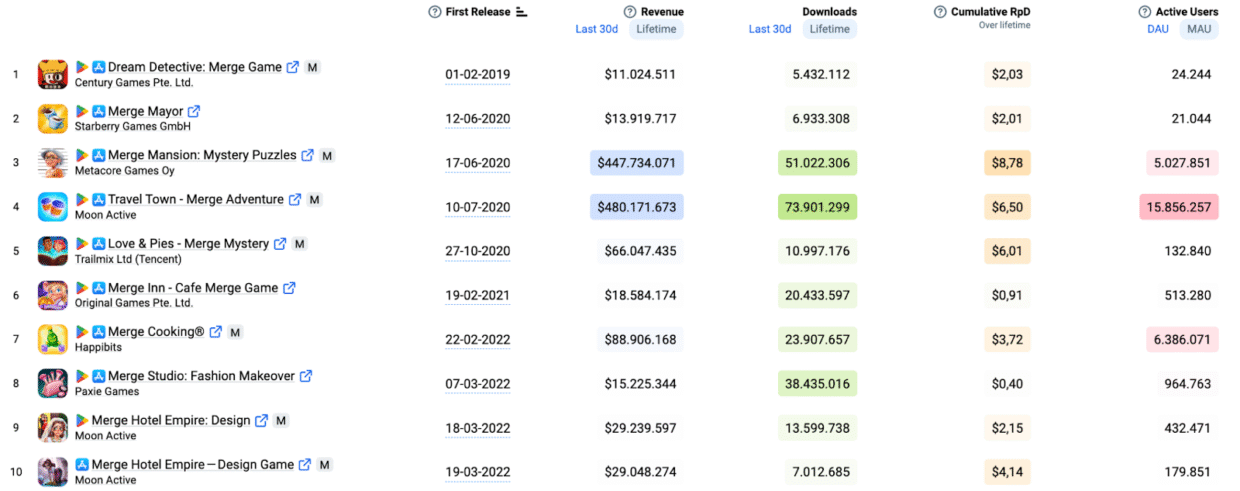
During this period, several smaller but noteworthy titles also emerged, including Love & Pies by UK-based developer Trailmix, and Mergedom by Bigger Games.
Interestingly, Mergedom was led by Yankı Yağız Akpek, who would later go on to found Pine Games.
In February 2023, the project was acquired by Original Games, one of the leading studios in the Merge-2 space.
The deal stood out as the first Merge-genre exit in Türkiye’s gaming ecosystem, marking a milestone moment for the local industry.

While Metacore and Moon Active were dominating the market, a wave of smaller yet successful Merge-2 titles continued to appear.
Then, in June 2022, an Asian developer named Microfun made a powerful entrance into the Merge-2 scene.

Microfun’s breakout title, Gossip Harbor, quickly became the top-grossing and most-downloaded Merge-2 game worldwide.
Unlike ever-green studios, Microfun adopted a fast-adaptation strategy, moving swiftly with market trends rather than defining them.
Its follow-up title, Seaside Escape, echoed many of Travel Town’s strengths, reinforcing Microfun’s dominant position in the Merge-2 market.
Beyond these two hits, the company kept experimenting with new concepts, adapting popular titles from other genres into its own ecosystem. This approach helped Microfun build a reputation as a consistently active and prolific studio, always present in the Merge-2 space.
Over the years, the Merge-2 genre has shown remarkable commercial stability and growth, becoming one of the safest subgenres in mobile gaming, with many titles surpassing 1M+ downloads and $1M+ in lifetime IAP revenue.

It seems Pine recognized this landscape by late 2024.
With Viking Island, the studio stepped onto the scene with its own original IP, a Merge-2-based game built around deep meta systems and a strong creative identity.
Viking Island
Viking Island officially launched on June 5, 2025.

A new player learns the basics in the first few minutes, step by step.
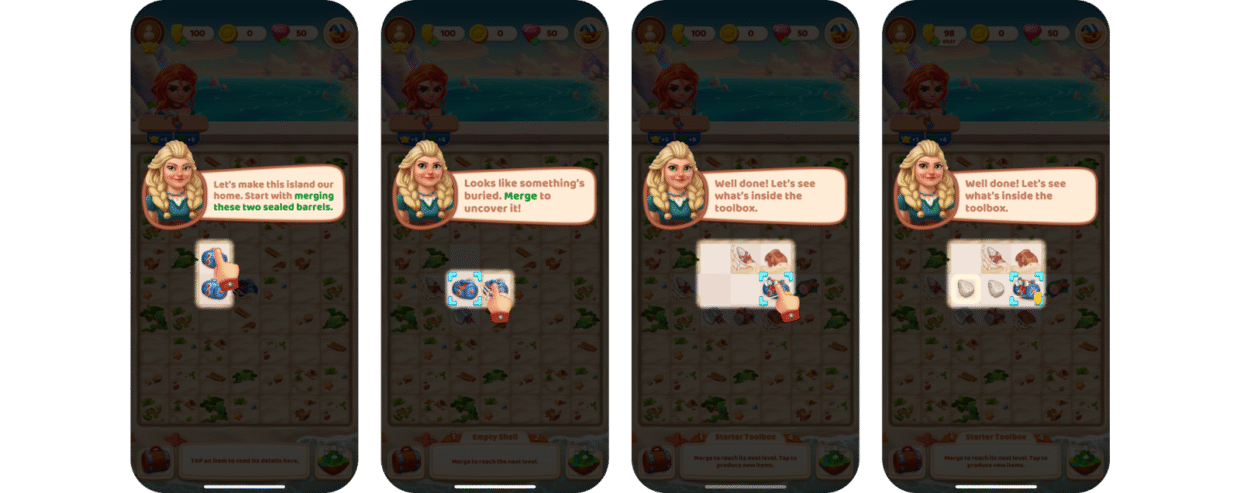
You start by merging two level-1 bags to create a level-2 bag.
Next, you merge that new level-2 bag with another locked bag of the same level on the map, and congratulations, you now have a level-3 generator.
Tapping the generator produces new objects. Within the first 30 seconds, the player has already learned the four core actions of the game:
- Tap the generator to produce items
- Merge identical objects
- Unlock new areas
- Expand the board
From here, the tutorial flows naturally into the main gameplay loop.
Items produced by the generator are merged to create the objects requested in the order system at the top of the screen. Once the requested object is ready, the player hits the “Serve” button, earning resources and currencies that drive progression and unlock new layers of play.

With these newly earned resources, the player heads to the Island Map, the very heart of Viking Island, and begins restoring and upgrading the island step by step.

Looks calm. So peaceful.
And yet, a refreshing surprise in today’s mobile market, where we’ve grown used to seeing CRYING BABIES, over-the-top drama, and objectified female characters dominating storylines.
Viking Island quietly breaks that noise with its grounded, artful tone, a reminder that you can still build emotional depth without cheap theatrics.
And that’s likely what truly sets Viking Island apart from the genre’s giants.
Instead of relying on emotional manipulation or sensational marketing tricks, it delivers a genuine sense of satisfaction born purely from its core gameplay.
That’s rare and ‘valuable’ because truly ever-green games stand the test of time through strong mechanics, not artificial drama.
Now, let’s take a closer look at the early-stage systems.
In Viking Island, there are five distinct item groups, each introducing a unique production chain that adds depth and variety to the overall gameplay loop.

The first item group is the Bag. When opened, it randomly produces either stones or gloves.
The stone chain can be merged and evolved into tools like spears, sickles, hammers, shovels, axes, and pickaxes, progressing through up to 14 levels.
The glove chain, on the other hand, is shorter; it caps at five merge levels, offering a quicker, more compact progression path.
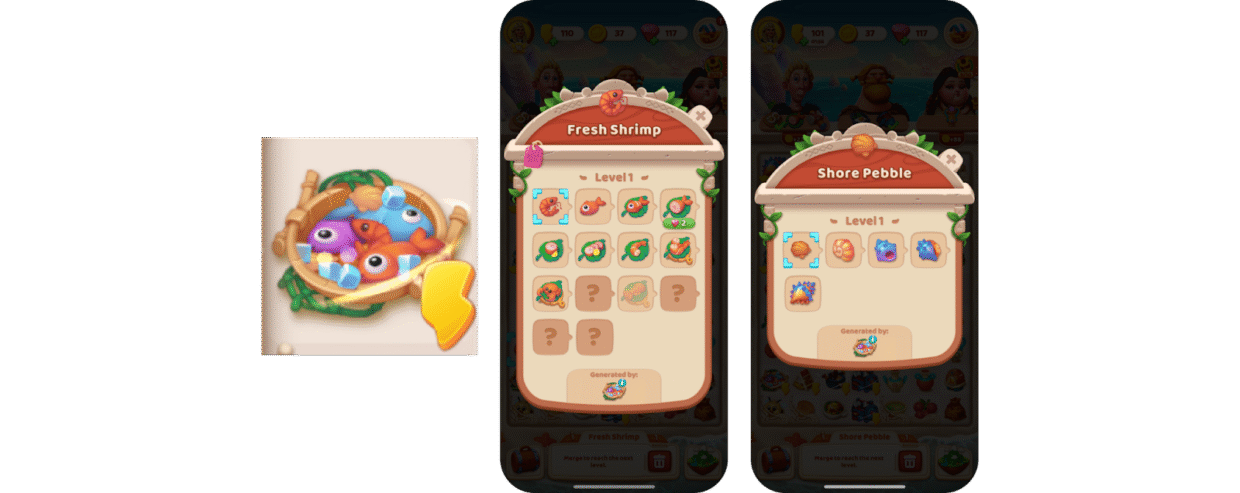
The second item group is the Fishing Net.
From it, players can obtain either shrimp or seashells.
The shrimp chain merges into sea-themed objects like fish and crabs, progressing through up to 14 levels, while the seashell chain offers a shorter, 5-level loop.
Both the Bag and Fishing Net serve as the core generators during the early stages of the game. Each produces two possible item types, adding a layer of controlled randomness.
This element of chance triggers a subtle “near-miss effect”, every energy spend keeps the player anticipating that next, unexpected outcome, maintaining excitement with every tap.

The third item group adds real depth to the production chain: the Coop and Egg System.
Here, players manage two generators: the chicken coop and the egg basket.
First, the player hatches from the coop to create a level-5 egg basket generator. This basket can produce up to 12 eggs in total. Once the 12th egg is generated, the basket disappears, meaning players must merge up again to rebuild it.
The egg chain itself can evolve into 10 different food items through merging.
As players progress, new twists start to appear. For example, unlike the endlessly reusable Bag or Fishing Net, the egg basket has limited uses, forcing players to think strategically about timing and energy.
The challenge ramps up, production takes longer, energy demands increase, and reaching high-tier items feels more rewarding when achieved.
Sure, some players might get frustrated or impatient, but the balance here is surprisingly well-tuned, pushing effort just enough to make every success satisfying.
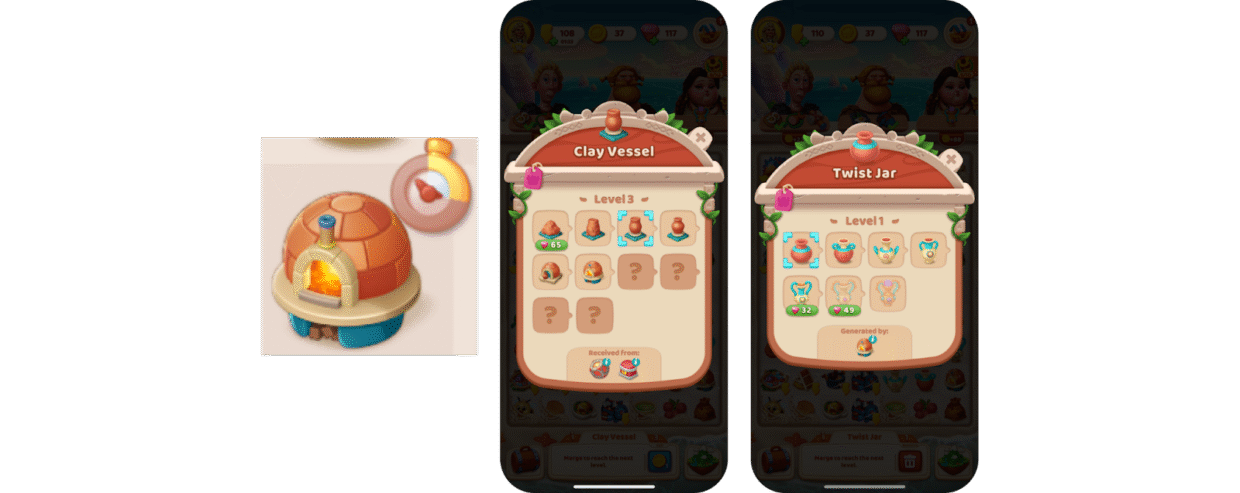
The fourth item group introduces a new cycle built around clay and heat, the Kiln & Vase system.
At this stage, players must once again craft step by step: starting with clay, merging into pots, and finally producing a kiln.
But this time, there’s a key twist:
The kiln offers unlimited use, but it’s time-restricted.
Roughly every 50 minutes, it can produce only six jars before entering cooldown.
This design represents the third evolutionary step in Pine’s merge loop structure:
- Bag & Net → Unlimited use
- Egg Basket → Limited production count
- Kiln → Time-limited generation
This gradual progression keeps the player’s mental focus diversified; even while waiting, there’s always something to manage or anticipate. Once the player has fully experienced the main dopamine loop, the game subtly introduces soft monetization.
The waiting period triggers a natural desire for progress, offering players a choice: wait it out or pay to speed it up. This creates an organic IAP motivation, not through pressure, but through smart design.
And it’s exactly at this point that the game unveils its first direct monetization loop: the Daily Shop.
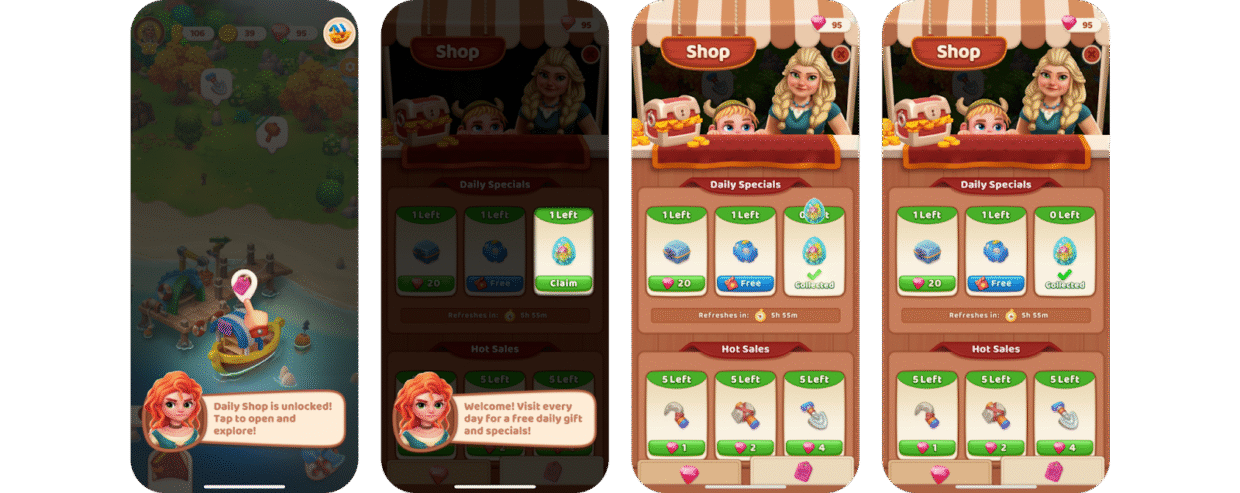
Each day, players are presented with three main options:
- Free Gift – completely free, available for everyone
- Ad Rewarded Item – unlocked by watching a short ad
- Premium Item – purchasable with gems
In addition, there’s a special section called “Hot Sales”, designed to directly tap into the “stay in flow” impulse mentioned earlier.
Instead of spending energy and time producing items, players can instantly purchase six offered items, turning that moment of waiting into a smooth, optional monetization opportunity.

From a design standpoint, one clear message to the Players:
“Don’t spend your time or energy; spend to move forward instantly.”
It’s a textbook example of a “friction-to-purchase bridge” in Merge-2 economies. Whenever players face an energy bottleneck, these offers appear, promising low effort and quick progress.
As a result, the system drives spending without breaking the gameplay flow, keeping the experience smooth and continuous.
Alongside the shop, the game also gives players additional options like purchasing energy packs, offering even more ways to accelerate progression and stay engaged.
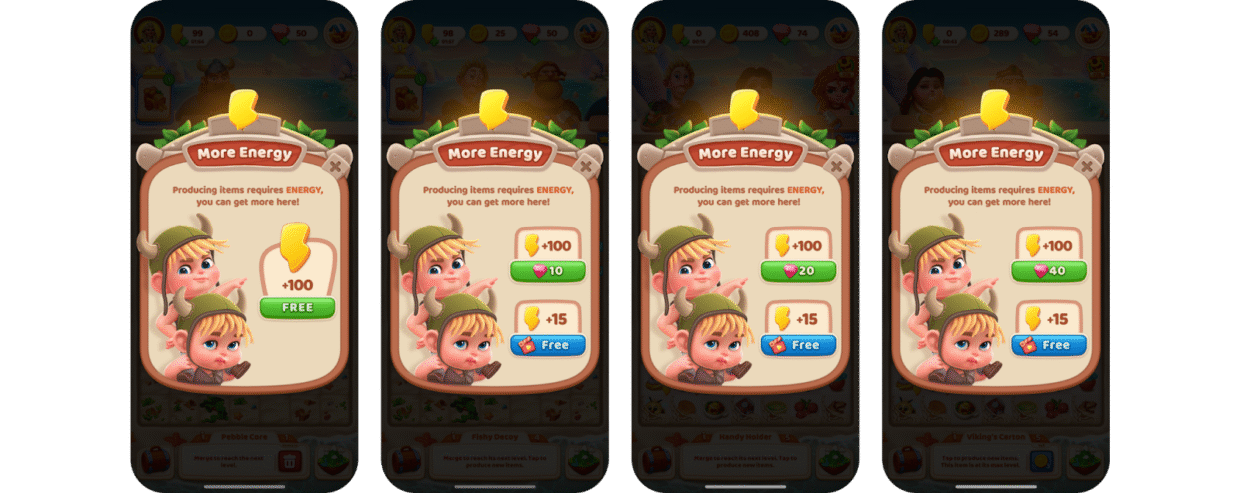
At the start, the game grants players 100 free energy to get them rolling.
But after that, the balance begins to shift:
- 100 energy costs 10 gems
- Or, players can watch one ad to earn 15 energy
Each purchase slightly increases the price, creating a gradual escalation curve that encourages smarter spending decisions.
If players choose not to engage with the rising costs, the game offers an alternative progression system, the Firefly Charge.
It’s a clever mechanic that keeps players moving forward without feeling hard, stopped by the economy.
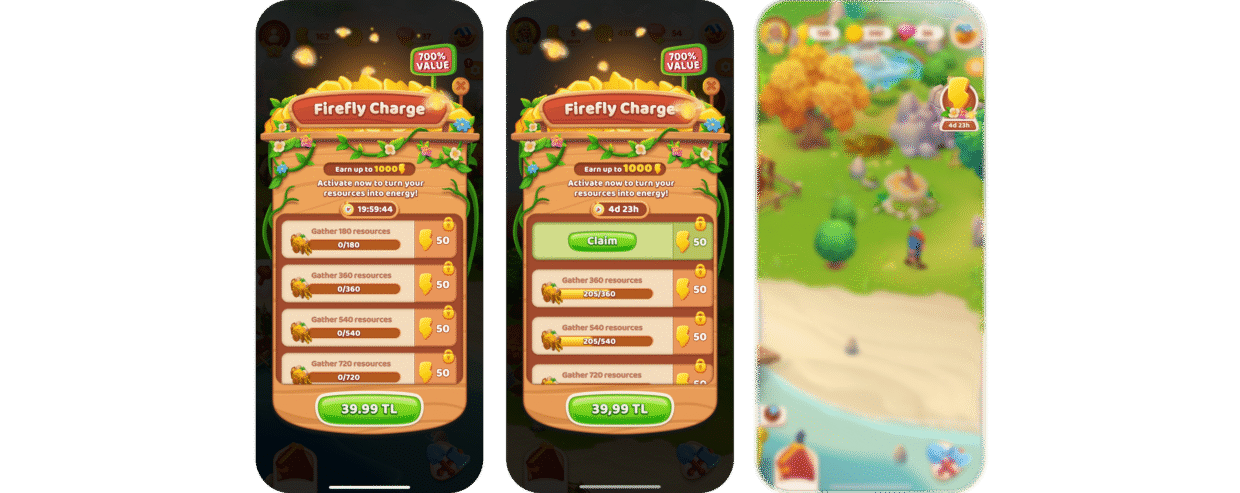
The Firefly Charge is essentially a time-limited quest system built around energy motivation.
Players purchase this pack with a one-time payment, then earn energy rewards over five days by completing daily missions.
While the value of premium quest systems like Firefly Charge can be debated, Viking Island’s core progression remains fully accessible to everyone.
It’s anchored in a level-based reward path, ensuring that steady play, not just spending, keeps players moving forward.
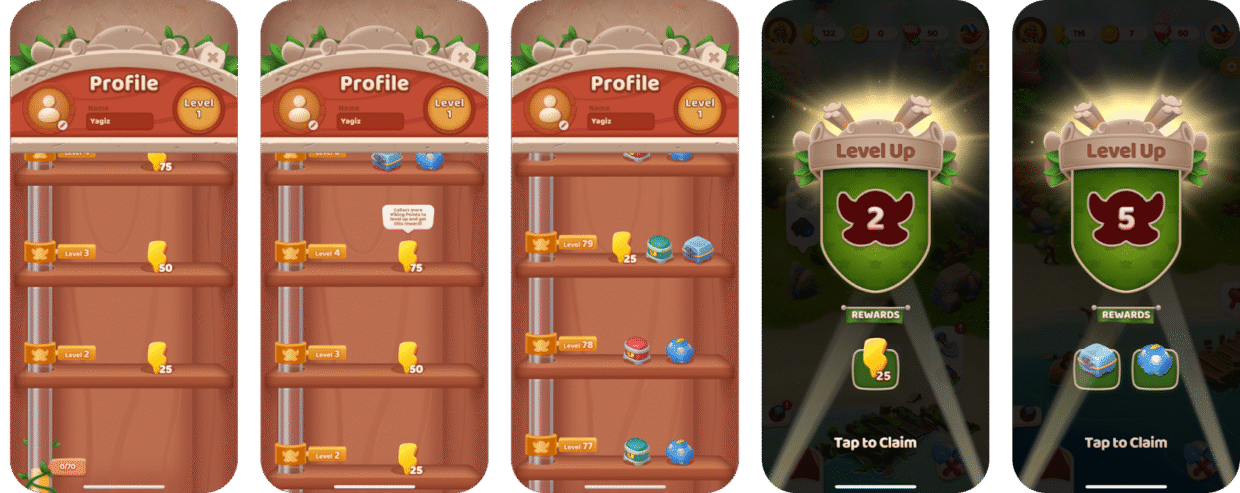
Each time the player levels up, they receive a reward, sometimes energy, sometimes a mystery box containing random items. In the early version, this system extends up to level 100, with each milestone offering small but motivating rewards that keep players engaged.
XP is earned exclusively through Island Decoration tasks, where completing objectives grants Viking Points, the game’s progression currency.

This system naturally pushes players to stay active in the merge area, completing orders, producing resources, and managing space efficiently to progress faster.
And speaking of space, it’s worth remembering: in Merge-2 games, the board itself is the player’s most limited and strategic resource. In Viking Island, the board is a 7×9 grid, giving 63 total cells.
To create a level-5 object, the merge chain works like this:
2 level-1 objects → 1 level-2
4 level-1 objects → 1 level-3
8 level-1 objects → 1 level-4
16 level-1 objects → 1 level-5
That means producing even a single high-level item can occupy nearly a quarter of the entire board — making space management absolutely critical to long-term success.

This is where the Inventory system comes into play. Players can move items that block the merge area or aren’t immediately needed into a free 6-slot inventory.
Later on, they can unlock additional slots with gems, a purely Quality of Life (QoL) monetization choice that offers convenience and organization, not a direct gameplay advantage.
As players progress, Viking Island introduces several event systems designed to refresh the flow, break monotony, and give players a sense of side objectives. Among these, two features stand out: Lava Vault and Multiplier Booster.
Lava Vault
Appearing a bit later in the game, the Lava Vault acts as a smart supplemental system that ensures the experience isn’t limited to decoration and merging alone.

The idea behind it is simple but effective: to give players more than one goal to chase.
Each completed task rewards a certain number of Keys, and as these accumulate, the player gets closer to unlocking the Vault. The big mystery reward inside keeps curiosity and anticipation alive throughout the process.
What makes this system shine is that it doesn’t rely on a single gameplay loop.
Players aren’t just following the classic “order → reward → decorate” cycle — they’re also progressing toward opening the Vault at the same time. In the end, Lava Vault delivers both short-term satisfaction and a long-term objective, layering the experience with just the right amount of motivation and anticipation.
Multiplier Booster
Unlocking right after the Lava Vault, the Multiplier Booster adds a subtle but eye-catching casino-like flair to the game.
Simply put, it runs on a “spend more energy, win bigger rewards” logic, inviting players to take small, calculated risks for the chance at greater payoffs.
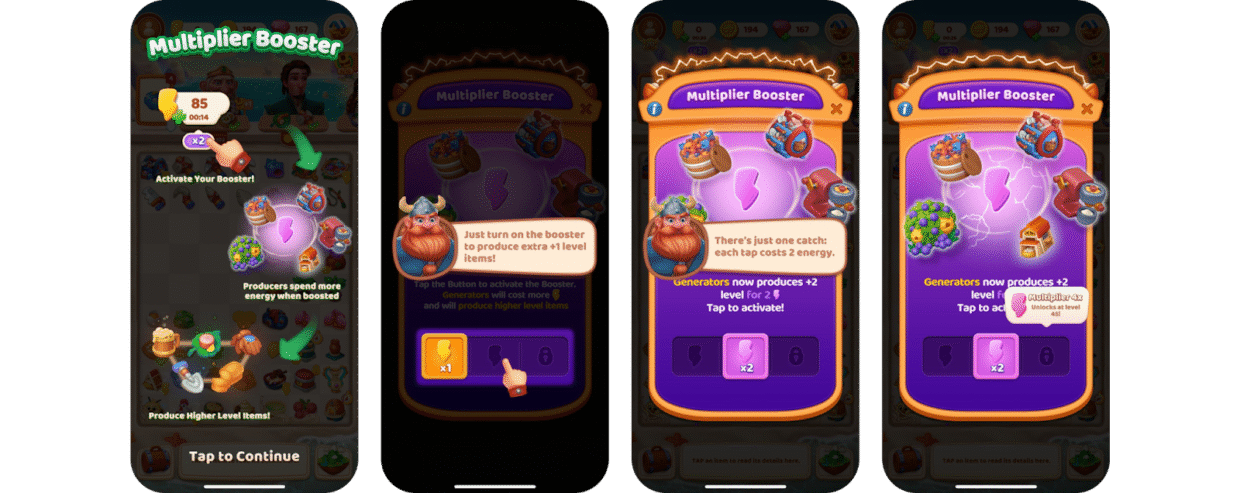
When the Booster is active, each tap consumes more energy, but in return, the item level output increases.
You can play it safe and go with a +1 energy boost, or push your luck with +2, even +4 if you’re feeling bold.
This mechanic injects a fresh thrill into the Merge-2 loop. It captures that classic “high risk, high reward” excitement you’d find in a casino — that instant rush when you take a chance and actually hit something big.
Some players use it strategically to speed up progression, while others chase the “maybe this time” feeling just for the adrenaline.
At the end of the day, everyone loves to test their luck a little, and Viking Island understands that perfectly.

🎁 Bonus: We Went All In.
While digging into this story, we ended up taking 700+ screenshots from Viking Island!
They were too good to keep to ourselves, so here they are:

👉 Download all the visuals here. Free & Open
If it inspires you or helps in any way,
just spread the word: tell a friend, share the article, or follow along for the next one.
That’s more than enough for us, really…






